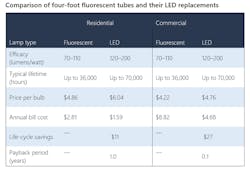It will soon be lights out for most new fluorescent lighting in Vermont, a development that could accelerate its demise elsewhere and fuel LED lighting’s continued rise.
In May, the state became the nation’s first to pass legislation phasing out the 4-ft fluorescent tube, commonly used in many commercial and residential settings. The law will ban sale of the tubes in Vermont by 2024, further expanding the state’s push to rid the market of fluorescent lighting that started earlier this year with an administrative ban on the sale of general-purpose screw-based fluorescent bulbs by February 2023.
The legislation turns on specifically on the state’s power to address threats to the environment and public health, including mercury contamination and exposure that occurs when mercury-containing fluorescent bulbs break and the substance is released. Since fluorescent bulbs are routinely thrown in the trash rather than disposed of in an environmentally friendly way, lawmakers also justified the ban on the basis of energy efficiency. Since more economical LED lighting has steadily improved and become more available, it can now be readily substituted for fluorescent lighting, the state argued, yielding energy savings and a cleaner environment. The legislature, however, was limited by federal law in its ability to ban fluorescent lighting by imposing stricter energy efficiency mandates on lighting products.
A group representing lighting suppliers, National Electrical Manufacturers Association (NEMA), took issue with the state’s reasoning. While acknowledging the mercury problem, NEMA said there should be a longer phase-out period because fluorescent bulbs are not yet easily replaced with substitutes. In a November 2021 letter to the Vermont Department of Environmental NEMA argued that “while alternative lighting solutions DO exist for a variety of mercury-added lamps currently in use, many are not available at a “cost equal to or better” than their mercury counterparts. Moreover, the non-mercury products often do not constitute direct, ‘plug-in’ replacements for mercury-containing lamps.”
In the wake of the law’s passage, a NEMA spokesperson in early July said the state’s consumers, businesses, contractors, and suppliers will be unnecessarily burdened.
“A longer transition time could enable replacements to be provided in sufficient numbers and for consumers and commercial building owners to identify appropriate replacements and obtain them in sufficient numbers while at the same time, Vermont’s industry funded program to collect spent fluorescent lamps continues to operate,” Spencer Pederson, vice president, public affairs, told EC&M.
But in defending the state’s action, The American Council for an Energy-Efficient Economy (ACEEE) takes issue with NEMA’s claim. It says economical and functional substitutes are now available in sufficient quantity. In a recent study, the body says “mercury-free LED replacements for linear and compact fluorescent bulbs are widely available and provide the same or better lighting, longer product life, and much lower total cost than fluorescents.”
“There are a number of states considering similar proposals and we are working with legislators to ensure a smooth transition that does not overburden consumers,” Pederson says.
Tom Zind is a freelance writer based in Lees Summit, Mo. He can be reached at [email protected].




